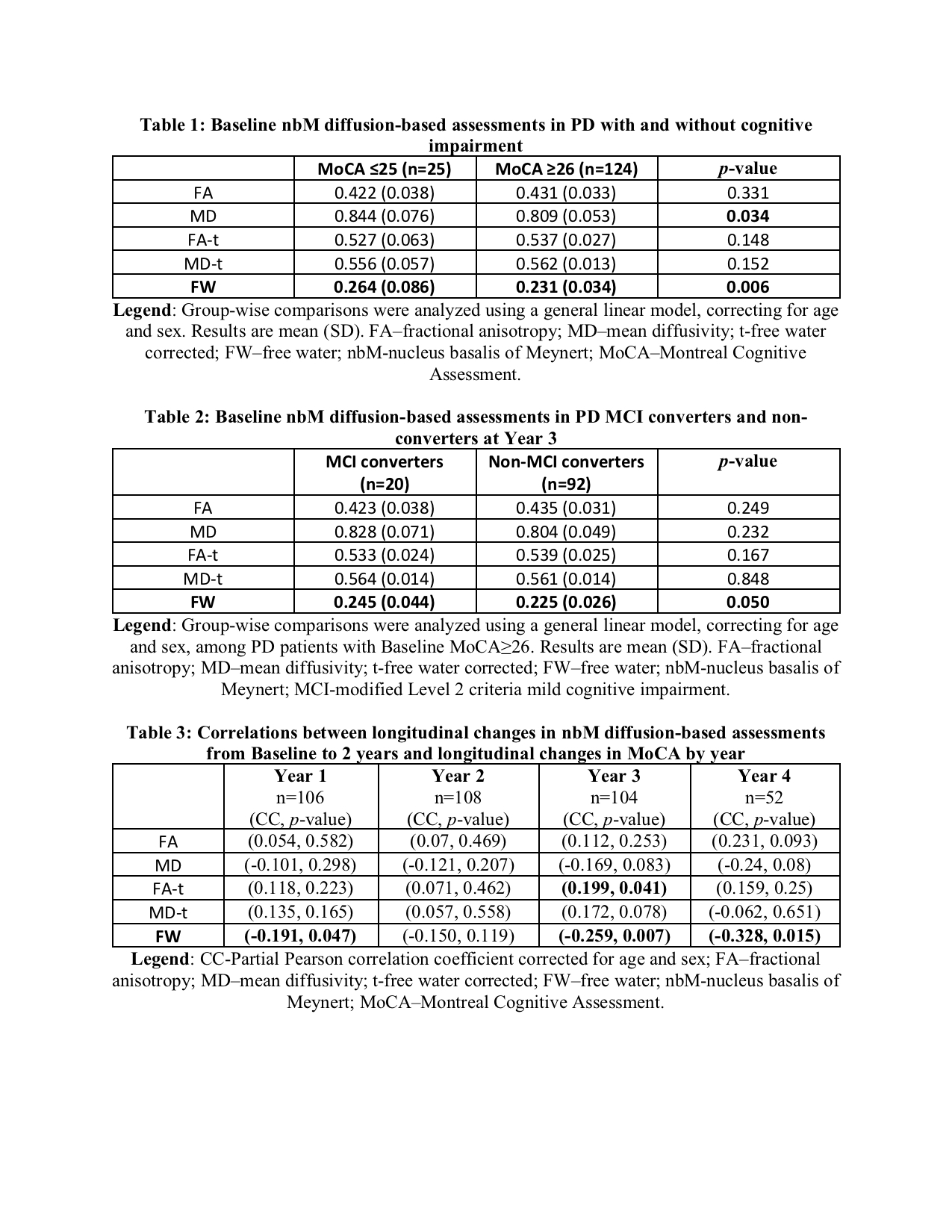Category: Parkinson's Disease: Neuroimaging
Objective: To explore diffusion-based MRI assessments of the nucleus basalis of Meynert (nbM) as a neuroimaging biomarker of cognitive abilities and longitudinal cognitive changes in Parkinson’s disease (PD).
Background: The nbM provides a major cholinergic input to the cortex and is an early site of degeneration in Alzheimer’s disease.1 In PD, diffusion tensor imaging (DTI) assessments of the nbM were previously shown to distinguish and predict cognitive impairment;2 however, no previous studies have assessed how free-water (FW) compares with DTI for these outcomes and if longitudinal changes in diffusion-based assessments correlate with changes in cognition. FW quantifies extracellular water within a voxel that likely reflects tissue atrophy and/or inflammation.3, 4 In the substantia nigra, FW is more sensitive to longitudinal changes than DTI in PD.5-7 We evaluated how nbM FW compares with DTI for cognition outcomes in PD patients from the Parkinson’s Progression Markers Initiative (PPMI).
Method: A total of 149 PD patients (mean disease duration=6.9 months) from PPMI with valid Baseline DTI data were analyzed (downloaded April 2018). Utilizing the same definitions as the previously mentioned PPMI study,2 cognitive impairment at Baseline was defined as a Montreal Cognitive Assessment (MoCA) score ≤25, while modified Level 2 criteria mild cognitive impairment (MCI) was defined as a MoCA ≤25 with at least two cognitive test scores >1.5 standard deviations below the standardized mean score.8 MoCA was selected for the longitudinal analyses based on previous results showing sensitivity to change.9 The b=0 image from each MRI acquisition was non-linearly registered in MNI space using the Advanced Normalization Tools software package. The nbM was defined using a histologically-defined atlas. The diffusion tensor was calculated using both single tensor and bi-tensor models, with the later providing an estimate of free-water (FW) and FW-corrected DTI.3
Results: [Table 1]
[Table 2]
[Table 3]
Conclusion: NbM FW is more sensitive than DTI for distinguishing and predicting cognitive impairment and longitudinally reflecting cognitive changes in early Parkinson’s disease. These qualities support nbM FW as a promising cognition-progression biomarker in PD that could help identify cognition protective therapies in clinical trials.
References: 1. Schmitz TW, Nathan Spreng R, Alzheimer’s Disease Neuroimaging I. Basal forebrain degeneration precedes and predicts the cortical spread of Alzheimer’s pathology. Nature communications 2016;7:13249. 2. Schulz J, Pagano G, Fernandez Bonfante JA, Wilson H, Politis M. Nucleus basalis of Meynert degeneration precedes and predicts cognitive impairment in Parkinson’s disease. Brain 2018;141:1501-16. 3. Pasternak O, Sochen N, Gur Y, Intrator N, Assaf Y. Free water elimination and mapping from diffusion MRI. Magn Reson Med 2009;62:717-30. 4. Pasternak O, Shenton ME, Westin CF. Estimation of extracellular volume from regularized multi-shell diffusion MRI. Med Image Comput Comput Assist Interv 2012;15:305-12. 5. Ofori E, Pasternak O, Planetta PJ, et al. Longitudinal changes in free-water within the substantia nigra of Parkinson’s disease. Brain 2015;138:2322-31. 6. Burciu RG, Ofori E, Archer DB, et al. Progression marker of Parkinson’s disease: A 4-year multisite imaging study. Brain 2017;140:2183–92. 7. Guttuso T, Jr., Bergsland N, Hagemeier J, Lichter DG, Pasternak O, Zivadinov R. Substantia Nigra Free Water Increases Longitudinally in Parkinson Disease. AJNR Am J Neuroradiol 2018;39:479-84. 8. Weintraub D, Simuni T, Caspell-Garcia C, et al. Cognitive performance and neuropsychiatric symptoms in early, untreated Parkinson’s disease. Mov Disord 2015;30:919-27. 9. Caspell-Garcia C, Simuni T, Tosun-Turgut D, et al. Multiple modality biomarker prediction of cognitive impairment in prospectively followed de novo Parkinson disease. PLoS One 2017;12:e0175674.
To cite this abstract in AMA style:
T. Guttuso, Jr., D. Tosun, R. Zivadinov, O. Pasternak, D. Weintraub, N. Bergsland. Nucleus basalis of Meynert free-water distinguishes and predicts cognitive impairment and longitudinally correlates with cognitive changes in early Parkinson’s disease [abstract]. Mov Disord. 2020; 35 (suppl 1). https://www.mdsabstracts.org/abstract/nucleus-basalis-of-meynert-free-water-distinguishes-and-predicts-cognitive-impairment-and-longitudinally-correlates-with-cognitive-changes-in-early-parkinsons-disease/. Accessed December 20, 2025.« Back to MDS Virtual Congress 2020
MDS Abstracts - https://www.mdsabstracts.org/abstract/nucleus-basalis-of-meynert-free-water-distinguishes-and-predicts-cognitive-impairment-and-longitudinally-correlates-with-cognitive-changes-in-early-parkinsons-disease/

